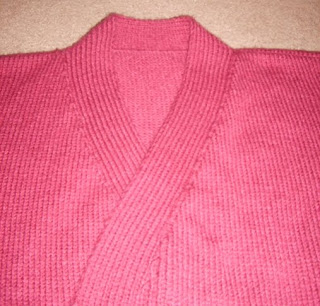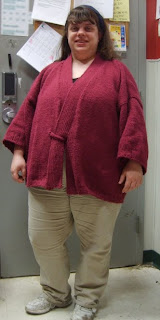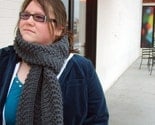
I was going to write about the use and relevance of stitch markers, but then I figured, what would be more helpful than an intro to stitch markers? A guide to the beginning knitter's tool kit! This is part one of an indeterminate amount of posts on the subject, so be sure to check back.
When you begin knitting, you'll find that there is a lot of accoutrement to choose from. Obviously you'll need needles and yarn to start, but then you find out that you need to keep track of about a thousand other variables: measuring your needles and gauge swatches, keeping track of stitch count when you're making something or working a particular stitch pattern, counting your rows - to name but a few! So here are a few pointers to get you started.
But first, get a beverage. This could take a moment!
Needles
Obviously! But what sort to get? Obviously, you don't want to lay out your hard-earned cash on some very fancy needles when you're just getting acquainted with the craft. What if you don't get along with knitting very well?
When I began my knitting odyssey, I bought a pair of size 10 short needles designed for children - one was red, the other blue, and they were both capped off with a very cute plastic kitty head. The purpose of different coloured needles was to help identify which side of the knitting was which while beginning, and it didn't hurt that they were very cute! The short length made it easy to work on small swatches to start with, and the diameter - 6mm - is a good, middle-of-the-road size for understanding how the needles work - not too small and not too big (I can't imagine anything more discouraging to the newbie knitter than tiny, tiny needles... it would take days to knit a decently-sized swatch!).
After that, I bought more, in various sizes - mostly large. They were colourful acrylic, some lightly coloured and see-through with glitter on the inside. I found out that a see-through needle looks very cool, but can be confusing since you can see all of your stitches from both sides (it looked like there were twice the stitches!), but a darker, more opaque colour worked fine. They do have a tendency to be squeaky and for the stitches to stick and not move freely - though I think this was partly the material, partly my tight-knitting issues at the time. Not all plastic needles are created equally - some work better for the individual knitter than others. It's a matter of personal preference - but I did find
Daisy Needles to work very well as they are light-weight and smooth, and every size is a different colour, so you can tell them apart at a glance.
Wooden needles work well, too - I do recommend starting with bamboo (
Clover Takumi is a great brand - lightweight and very smooth with enough traction to keep the stitches on the needle, so no worry about them slipping off), though I myself pine for a pair of rosewood needles (they look so pretty but are also sort of pricey).
As for metal needles, the stand-by is aluminum - what my grandmother used. The surface of aluminum needles tend towards a matte finish, so stitches won't go flying off them (same with wood), but personally, I find the noise they make as they rub against each other to be most irritating! I'd use them if there were absolutely no other needles in the world, but I favour nickel-plated. They have a fairly slick surface, which is why they are known for fast-paced knitting, but this property may not work so well for the beginner knitter. If you want to give them a whirl, I suggest the
KnitPicks range - they're fairly inexpensive. Unlike, say,
Addi Turbos, which are ridiculously addictive but kind of pricey (but oh, so good).
Needle Sizing
Here is a
handy dandy list of needle sizes - it lists the diameter in millimetres (mm), then the US needle size, then the Canadian/UK sizes for easy conversion and identification.
When you're just starting out, I recommend a range from size US 7 - US 11. Like I mentioned earlier, beginning with very small needles may be discouraging. If it takes you a couple of days to knit a swatch when you begin, what impetus is there to keep going? I began with size 10, but if you're practicing with a worsted weight yarn - which is pretty middle of the road - size 8s are the way to go, as it is the needle size most recommended for that weight. (We'll talk more about the relationship between needle size and yarn weight in an upcoming post.) As you keep knitting, you will want to branch out to other fibres, yarn weights, and needle sizes, and will add to your collection with those things in mind.
Plenty of big-box crafting stores, such as
Hobby Lobby or
Michael's, offer needles not just in individual pairs but in packages of several sizes. (
This is an example of the acrylic needles I mentioned earlier, in a three-size pack. They are a fine way to start out and experiment with needle sizes.)
Straights vs. Circulars
A couple of the needle types that I've linked to are circular, not straight, as you might be used to seeing. Straight needles are single-length with a stopper on one end, and work well for smaller pieces of knitting, like a scarf, or the front part of a cardigan. Circulars are comprised of two needle tips, about 3 - 5" in size, joined together by a flexible plastic cord. The cord holds the majority of the stitches, and come in a range of sizes from 16" (good for hats) to 60" (good for large pieces of knitting, like large lace pieces and afghans). You can find these as "fixed" (the needle tip is permanently joined to the cord) or "interchangeable" (the needle tip screws onto the cord, so you can change out length of cord depending on the project). While you may want to begin on straights - they are fairly straightforward to use, if you'll excuse the unintentional pun - a switch to circulars is fairly natural. They have advantages - one, you can knit circularly, without having to seam up fabric. Or you can knit back and forth like normal, being able to knit longer widths without having all of your stitches squished up on a straight needle. They are also friendlier on your wrists and hands, since on a larger piece of knitting, the resultant fabric will sit in your lap or on your work surface, not putting all of the weight onto one hand or another. And a final advantage that pretty much sealed the deal for me is that you can't lose one needle when you put down your knitting! It can be economical, too, to buy a kit of interchangeable needles. It's certainly something to think about when you move from beginning to intermediate knitting.
DPNs
AKA, double-pointed needles. Newbs, we will come back to this one! I remember when I began knitting, one of my knitting buddies, Sarah, mentioned "DPNs" in a chat and I was like, "whoa, whoa, back up. What?" ...now they're one of my favourite things. But back then, the idea of having your seamless knitting hanging from three or four other needles while you worked with one? It blew my mind. It might be doing the same to you. So for now, know that they're out there - we'll get back to it!
Yarn
Yarn choice is a little trickier - what you use depends on many variables and what sort of projects you're hoping to complete. When you are beginning, there is no sense in cultivating yarn snobbery! Acrylic has come a long way from the scratchy, squeaky, human-made fibre of yore. (My personal favourite is the Hobby Lobby in-house brand, "I Love This Yarn" - it is ever so soft and works very well for all sorts of projects.) It is non-allergenic and comes in a variety of colours, and it is inexpensive. I'm not going to lie to you - knitting can become a pretty expensive hobby once you get going, mostly because of fibre choice and the nature of Stash Addiction (where one cannot help but keep buying yarn for this-or-that project, or because of the "Ooh, Pretty!" factor, or any number of reasons, that turns a small collection of various yarns into a bona fide Stash). Which is why it pays to not be terribly choosy when you are beginning! When you're learning how to cast on, or how to tell knit from purl... do you really want to be wasting forty bucks worth of Mongolian cashmere? No, ma'am! You want to save better quality and luxury fibres for when you can appreciate them.
Having said that, wool can be pretty affordable if you know where to look - the aforementioned Hobby Lobby/Michael's type store does carry wool, and there's always
KnitPicks. Wool has a bad reputation for being scratchy and yucky - I think many of us might carry sensation memories from woolen goods in our childhoods. I know I do! But wool is a workhorse. Small imperfections can be blocked out (yes, we'll talk about that later, too!), it has excellent stitch definition which is great for pattern work and lacy knitting, and it is very warm - it can even keep you warm when it's damp. Though it needs a little special care when washing, you can find superwash wool that can be machine-washed and is softer than regular wool (it won't felt, but that is one of its advantages).
Some folks do have wool/animal-protein fibre allergies, so if you count yourself amongst that number, I do recommend sticking to acrylic or perhaps cotton when starting out.
Thus concludes today's Tips for Newbs! In the next issue we'll discuss tools for determining gauge and needle size, the use of tapestry needles, stitch markers, and row counters. (Can you feel the excitement? Can you?!)










